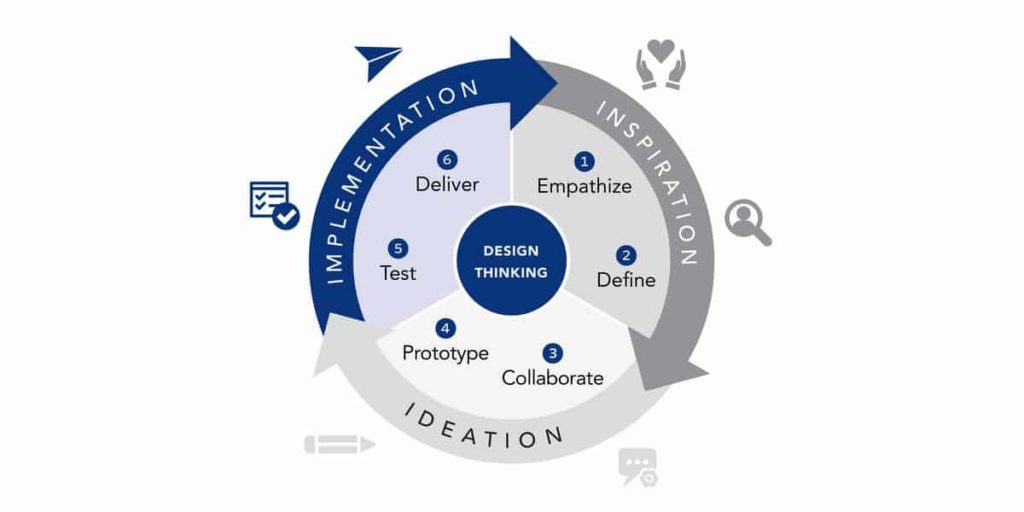How to Use Design Thinking for Better Leadership, Collaboration, and Innovation

Problem-solving, flexibility, and reacting to the new challenges of each day can be some of the biggest advantages in leadership. Design thinking, a familiar idea for product development, is also a powerful process for innovative problem-solving.
Did you know that design thinking can improve leadership, adaptability, and leading change? Regardless of your industry, you can use it to create a more innovative culture for leadership and problem-solving.
Therefore, we will show you the biggest advantages of using design thinking in your approach to leadership. Ultimately, we will give you tips and ideas to immediately implement in your organization.
What is Design Thinking?
Design thinking is a collaborative approach to problem-solving that can also be used to develop organizational strategy.
According to Tim Brown, CEO of IDEO, design thinking is “a human-centered approach to innovation that draws from the designer’s toolkit to integrate the needs of people, the possibilities of technology, and the requirements for business success.”
Here are the basic steps:
- Empathize: Set aside your own assumptions and understand the problem.
- Define: Use different activities and exercises to clearly define the problem.
- Ideate: Choose from a wide variety of techniques to generate ideas.
- Prototype: Create a model or simple version of the final product (or process).
- Test: Does the prototype solve the problem? What are the issues?
- Deliver: After multiple iterations, tests, and rounds of problem-solving, deliver the solution.
Design thinking not only works for designing tangible products, but also as a leadership approach. Design thinking helps the Florida Institute of Technology test and improve their spacesuit design. Similarly, it can help an HR team develop a new approach to managing the employee life cycle.
Design Thinking Can be Your Superpower, Even if You Don’t Develop A Product
Many organizations that we work with already use design thinking in their product development process. However, the real magic happens when they implement design thinking, also known as human-centered design, into their leadership approach.
Design thinking applies tools from the field of design for use in any industry. Above all, it puts the customer at the center of the innovation process. Anna Bracco, our in-house expert on design thinking and leadership, highlights the simplicity of design thinking and its ability to adapt to your organization’s needs. “It’s not rocket science. It’s just a different way of thinking about leadership.”
Think about a process that you would like to test or improve. Consider the problems you’re trying to solve based on the goals for your organization.
What Does a Design Thinking Organization Look Like?
Applying aspects of design thinking to your company can be incredibly valuable in promoting organizational adaptability.
First off, let’s look at a well-known example of two companies on opposite ends of the organizational adaptability spectrum. Netflix and Blockbuster were two video industry heavyweights with drastically different outcomes based on their ability to be flexible and empathize with their customers.
In 2004, Blockbuster was doing what worked: renting physical videos. Netflix, on the other hand, was “constantly re-evaluating what their customers want and need,” says Bracco. “Netflix was doing mail-order DVDs and then they launched online. This ended up disrupting their whole business. If Blockbuster had done something like that, maybe they’d still be around.”
Above all, organizations with a more agile approach are more apt to react to what’s happening in the environment. However, others are slow to move and slow to make changes. Therefore, by constantly ideating, evaluating, and testing their own processes, agile organizations are able to stay one step ahead.
Bracco underlines that you can react more quickly to changes in the industry and the landscape if you “have a constant understanding of what your customer wants and needs. Therefore, you can react to that versus being surprised like some of these large companies that have failed.”
You don’t have to disrupt an entire industry. Are you doing enough to disrupt and push the limits on your current processes? Do you have a culture of innovation?

Ignite Innovation and Lead Change
Gain the tools to build a culture of innovation and navigate change, inspired by space exploration insights.
Define Your Customer (Hint: They Might Not be The End Customer)
Design Thinking’s first two steps, Empathize and Define, require you to determine who your customer actually is and then look at the problem from their point of view.
Your customer isn’t always the end customer. If you work for Netflix, your end customer might be the binge-watching Grey’s Anatomy fan. If you’re the head of Human Resources at Netflix, your customer may be the employee or the team that reports to you, instead of the end customer.
Let’s look at another example. The financial and international accounting department of a large company needed to define their real customer. This team had no contact with the end customer. Therefore, to determine their actual customer, the team asked themselves questions such as:
- Who receives our numbers?
- Who interacts with those numbers?
- Do they need those numbers presented in a different way?
- How would it help them if we delivered the numbers in a different way?
After you define your customer, it’s easier to highlight what is important to them. As a result, you can ensure that the process or product you are designing fits their needs.
In your role, what are the questions you need to ask yourself and your team in order to discover your actual customer?
Innovate and Reduce Risk with Design Thinking
Bracco also works closely with space flight organizations in her work as a facilitator for our Launch Point Leadership Experience.
Understandably, risk is a main concern for these organizations. Risk is inherent in space flight. However, design thinking’s focus on identifying problems and testing solutions allows for problem-solving in the middle of production. As a result, this saves time and reduces risk at the end of production.
Consider the Human Spaceflight Laboratory at the Florida Institute of Technology. The Lab is helping develop Federal Aviation Administration guidelines for safer commercial spaceflight. By using human-centered design – and rigorous testing with a 500-pound simulator for human subjects – they anticipate various risks.
“There’s not a lot of incentive for commercial companies to spend money and time thinking about human factors,” says Ondrej Doule, Founder and Director of the Human Spaceflight Laboratory. Doule is also our Subject Matter Expert at our Launch Point Leadership Experience.
“They’re really focused on getting their vehicles to work. That usually means making a rocket work and putting a person in it. As a result of implementing design thinking, they collaborate with end-users such as astronauts and potential commercial flight customers. Therefore, they are able to make beneficial changes to spacesuit requirements.”
Your end product might not be as high-risk as spaceflight. But you can certainly minimize risk for leadership processes by following the design thinking methodology. Therefore, when you get to the high-stakes environment, you’ve already identified and addressed the potentially high-risk problems.
You Don’t Have to be Apple, Netflix or IDEO to Use Design Thinking: Start Small
Do you have to implement the entire design thinking process for your leadership to benefit? The short answer — no.
“You can use different pieces of it. You don’t have to revamp an organization and do things completely differently. There are practical tools and applications,” says Bracco.
The first step is to identify your customer. Bracco explains, “during our Launch Point Leadership Experience, we use customer empathy mapping. In this exercise, we determine the customer, the experience we want them to have, and the experience they want to have.”
Start right now! Take a look at who your real customer is. What are some ways you could immediately implement design thinking to better innovate and problem solve?
Design thinking is one of the leadership studies in our Launch Point Leadership Experience. Launch Point focuses on human-centered leadership through the lens of space flight. Contact us to learn more about customizing an experience to meet the needs of your company.
Author
Subscribe to get Access to Exclusive Content





